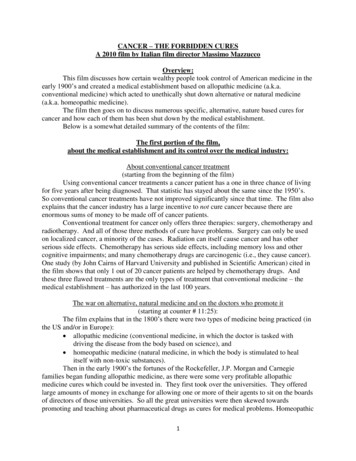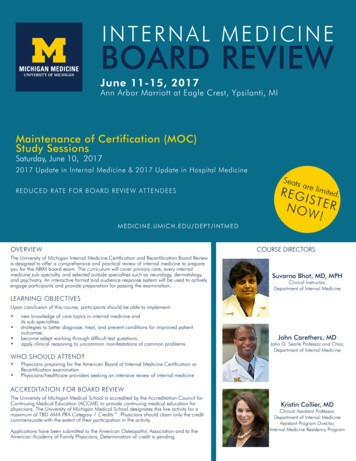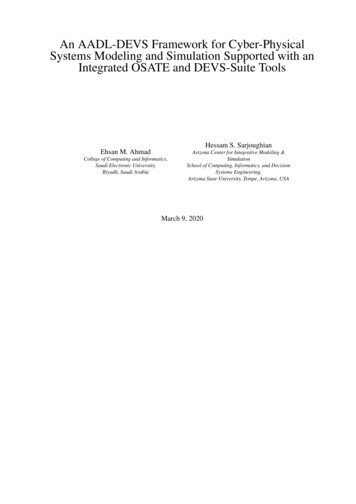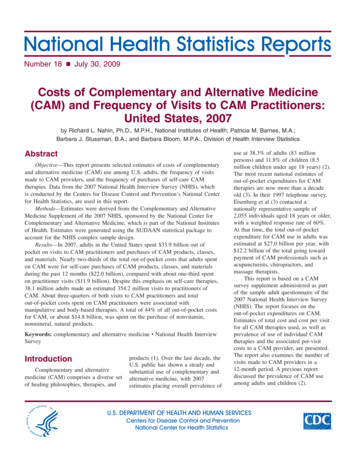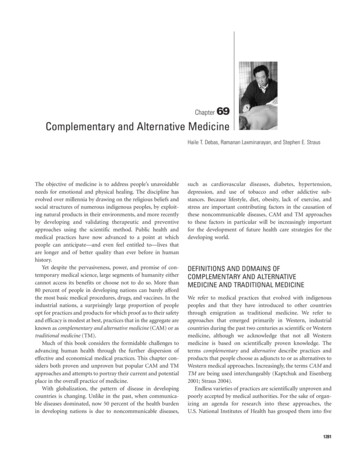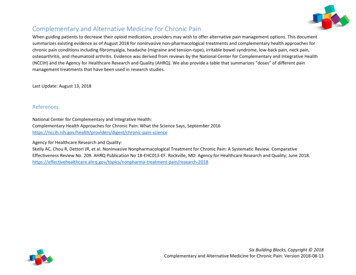
Transcription
Complementary and Alternative Medicine for Chronic PainWhen guiding patients to decrease their opioid medication, providers may wish to offer alternative pain management options. This documentsummarizes existing evidence as of August 2018 for noninvasive non-pharmacological treatments and complementary health approaches forchronic pain conditions including fibromyalgia, headache (migraine and tension-type), irritable bowel syndrome, low-back pain, neck pain,osteoarthritis, and rheumatoid arthritis. Evidence was derived from reviews by the National Center for Complementary and Integrative Health(NCCIH) and the Agency for Healthcare Research and Quality (AHRQ). We also provide a table that summarizes “doses” of different painmanagement treatments that have been used in research studies.Last Update: August 13, 2018References:National Center for Complementary and Integrative Health:Complementary Health Approaches for Chronic Pain: What the Science Says, September chronic-pain-scienceAgency for Healthcare Research and Quality:Skelly AC, Chou R, Dettori JR, et al. Noninvasive Nonpharmacological Treatment for Chronic Pain: A Systematic Review. ComparativeEffectiveness Review No. 209. AHRQ Publication No 18-EHC013-EF. Rockville, MD: Agency for Healthcare Research and Quality; June onpharma-treatment-pain/research-2018Six Building Blocks, Copyright 2018Complementary and Alternative Medicine for Chronic Pain: Version 2018-08-13
Table 1: Summary of existing evidence for noninvasive non-pharmacological treatments and complementary healthapproaches for chronic pain conditionsConditionStronger evidenceFibromyalgiaHeadacheMind and body approaches:Qi gong, Tai chi, yoga, mindfulness training, andbiofeedback, cognitive behavioral therapyFor migraine prevention:Butterbur (petasites)ExerciseMultidisciplinary rehabilitationMyofascial release therapyVitamin D for those with Vit. D deficiencyAcupuncture (for function but not pain)For migraine prevention: Riboflavin, magnesium,feverfew, coenzyme Q10, relaxation training, thermalbiofeedback combined with relaxation training, EMGbiofeedback, and cognitive behavioral therapyFor migraine treatment: biofeedback, massagetherapyTension headache prevention/treatment: relaxationtechniques, biofeedback, acupuncture, spinalmanipulationPsychological therapies, including hypnotherapyPeppermint oilOther herbal medicinesProbioticsIrritable BowelSyndrome(IBS)Low-Back PainLimited evidenceCognitive behavioraltherapyAcupunctureInsufficient evidence(Not enough evidence toconclude either way)Natural products (e.g.capsaicin containingcreams, S-adenosyl-Lmethionine (SAMe) or soy)Ineffective - Trialsdemonstrate noeffectMindfulnessbased stressreduction (shortterm effects)For tension headaches:Tai chiAcupunctureMelatoninMeditationYogaArtichoke leaf extractReflexologyUltrasoundSix Building Blocks, Copyright 2018Complementary and Alternative Medicine for Chronic Pain: Version 2018-08-13
ExerciseSpinal manipulation(osteopathic,chiropractic, eck PainOsteoarthritis(Studies oftenfocused on asingle jointtype. Refer toarticles formore age therapyTai chiFish oilMassage (for short term relief)Yoga (Viniyoga)Natural Products: devil’s claw and white willow barkand topical preparations of cayenne, comfrey,Brazilian arnica, and lavender essential oil(http://www.cochrane.org/CD004504/BACK herbalmedicine-for-low-back-pain)Mindfulness-based stress reductionFunctional RestorationLow level laser therapyManual therapies (primarily manipulation ormobilization)Combination exerciseLow-level laser therapyAlexander TechniqueAcupunctureMassage therapy (low level evidence)Herbs (ginger, avocado-soybean unsaponifiables(ASUs), Boswellia serrata, topical arnica gel andcomfrey gel)Ultrasound (short-term function and pain intensity)TractionSupplements: DMSO andMSM, SAMeCognitivebehavioral therapyGlucosamine orchondroitinTENSElectromagnetic FieldGLA (gamma linolenic acid)Thunder god vine (but has serious safety concerns:risks outweigh benefits)Mindfulness meditation, biofeedback, and relaxationtrainingTai chi (may improve function but not pain)YogaAcupunctureSix Building Blocks, Copyright 2018Complementary and Alternative Medicine for Chronic Pain: Version 2018-08-13
Table 2: Evidence for “dosing” of different pain management treatmentsMigraine PreventionButterburTwo studies show Petasites (purifed extract from the butterbur plant) to to be effective in reducing migraineattack frequency at a dose of 50mg BID in one study and 75mg BID in anotherGrossman W, Schmidramsl H. An extract of Petasites hybridus is effective in the prophylaxis of migraine. AlternMed Rev. 2001 Jun; 6(3):303-10.Lipton RB, Göbel H, Einhäupl KM, Wilks K, Mauskop A. Petasites hybridus root (butterbur) is an effectivepreventive treatment for migraine. Neurology. 2004 Dec 28; 63(12):2240-4.Low Back PainCognitive-behavioral therapyIn one study, patients who attended between 6-8 2-hour CBT sessions resulted in greater improvement in backpain and functional limitations at 26 and 52 weeks, as compared with usual careCherkin DC, Sherman KJ, Balderson BH, Cook AJ, Anderson ML, Hawkes RJ, Hansen KE, Turner JA. Effect ofmindfulness-based stress reduction vs cognitive behavioral therapy or usual care on back pain and functionallimitations in adults with chronic low back pain: a randomized clinical trial. JAMA. 2016 Mar 22;315(12):1240-9.In another study, six sessions of group CBT sessions (1.5 hours each) improved back pain disability scores whichwas maintained at 12 monthsLamb SE, Hansen Z, Lall R, Castelnuovo E, Withers EJ, Nichols V, Potter R, Underwood MR, Back Skills TrainingTrial investigators. Group cognitive behavioural treatment for low-back pain in primary care: a randomisedcontrolled trial and cost-effectiveness analysis. The Lancet. 2010 Mar 13;375(9718):916-23.ExerciseNot much can be concluded on the influence of exercise intensity, frequency, and duration on outcome. In onemeta-regression analysis of randomized controlled trials, authors found that number of exercise sessions issignificantly associated with the effect of exercise on low back pain at the short-term follow-up. Results suggestthat, for each additional exercise session, the effect size would increase by 0.13 (95% CI: 0.02, 0.24) on a 100point scale. The total number of exercise hours, however, was not significantly associated with exercise effectsize.Ferreira ML, Smeets RJ, Kamper SJ, Ferreira PH, Machado LA. Can we explain heterogeneity among randomizedclinical trials of exercise for chronic back pain? A meta-regression analysis of randomized controlled trials.Physical therapy. 2010 Oct 1;90(10):1383-403.See the following UpToDate article for specific recommendations: Exercise-Based Therapy for Low Back ed-therapy-for-low-back-painSpinal manipulationFindings from a large and rigorous randomized dose-response study of spinal manipulative therapy (SMT) forchronic low-back pain suggest that 12 sessions (SMT) may be the best “dose” for people with chronic low-backpain.Haas M, Vavrek D, Peterson D, et al. Dose-response and efficacy of spinal manipulation for care of chroniclow back pain: a randomized controlled trial. Spine Journal. 2014;14(7):1106–1116.Interdisciplinary rehabilitation(defined as an integrated intervention with rehabilitation plus a psychological and/or social/occupationalcomponent)Six Building Blocks, Copyright 2018Complementary and Alternative Medicine for Chronic Pain: Version 2018-08-13
Though it can vary, the most effective programs generally involve cognitive/behavioral and supervised exercisecomponents with at least several sessions a week, with over 100 total hours of treatmentChou, R., Loeser, J. D., Owens, et al. (2009). Interventional therapies, surgery, and interdisciplinary rehabilitationfor low back pain: an evidence-based clinical practice guideline from the American Pain Society. Spine, 34(10),1066-1077.Guzman J, Esmail R, Karjalainen K, et al. Multidisciplinary rehabilitation for chronic low back pain: systematicreview. BMJ2001;322:1511–16.Guzman J, Esmail R, Karjalainen K, et al. Multidisciplinary bio-psycho-social rehabilitation for chronic low-backpain. Cochrane Database Syst Rev 2002:CD000963.OsteoarthritisAcupunctureEvidence is not conclusively available for the ideal number of treatmentsIn one study, six or more acupuncture treatments were significantly associated with positive outcomes (P 0.03)Ezzo J, Berman B, Hadhazy VA, Jadad AR, Lao L, Singh BB. Is acupuncture effective for the treatment of chronicpain? A systematic review. Pain. 2000;86(3):217–25.ExerciseA systematic review of exercise for knee OA found that 24 total sessions and durations of 8 and 12 were theparameters most often associated with large effect sizes, and a frequency of 1 time per week were related to noeffect.Young JL, Rhon DI, Cleland JA, Snodgrass SJ. The Influence of Exercise Dosing on Outcomes in Patients With KneeDisorders: A Systematic Review. Journal of Orthopaedic & Sports Physical Therapy. 2018 Mar;48(3):146-61.Massage therapyA study found that a 60-minute “dose” of Swedish massage therapy delivered once a week for pain due toosteoarthritis of the knee was both optimal and practical, establishing a standard for use in future researchPerlman AI, Ali A, Njike VY, et al. Massage therapy for osteoarthritis of the knee: a randomized dose-findingtrial. PLoS One. 2012;7(2):e30248.Tai chiOne study found that two 1-hour sessions per week was helpful in reducing pain and improvements in physicalfunctioning for patients with OA of the kneeWang C, Schmid CH, Iversen MD, et al. Comparative effectiveness of tai chi versus physical therapy for kneeosteoarthritis: a randomized trial. Annals of Internal Medicine. 2016;165(2):77-86.A meta-analysis found that a 12-week course of tai chi provides benefits of improvement in arthritic symptomsand physical function in patients with OA; however, long term benefits is not clearYan, Jun-Hong, Wan-Jie Gu, Jian Sun, Wen-Xiao Zhang, Bao-Wei Li, and Lei Pan. "Efficacy of Tai Chi on pain,stiffness and function in patients with osteoarthritis: a meta-analysis." PLoS One 8, no. 4 (2013): e61672.Rheumatoid ArthritisFish oilThere is no consensus on the recommended amount of fish oil supplementation for patients with RA. TheArthritis Foundation recommends fish oil capsules with at least 30% EPA/DHA up to 2.6 g, twice a oil.phpSix Building Blocks, Copyright 2018Complementary and Alternative Medicine for Chronic Pain: Version 2018-08-13
Evidence Tables for Alternative Treatments of Specific Chronic Pain ConditionsReference: AHRQ Noninvasive Nonpharmacological Treatment for Chronic Pain: A Systematic ronic-pain.pdfSix Building Blocks, Copyright 2018Complementary and Alternative Medicine for Chronic Pain: Version 2018-08-13
Six Building Blocks, Copyright 2018Complementary and Alternative Medicine for Chronic Pain: Version 2018-08-13
Six Building Blocks, Copyright 2018Complementary and Alternative Medicine for Chronic Pain: Version 2018-08-13
Six Building Blocks, Copyright 2018Complementary and Alternative Medicine for Chronic Pain: Version 2018-08-13
Six Building Blocks, Copyright 2018Complementary and Alternative Medicine for Chronic Pain: Version 2018-08-13
Aug 13, 2018 · chronic low-back pain suggest that 12 sessions (SMT) may be the best “dose” for people with chronic low-back pain. Haas M, Vavrek D, Peterson D, et al. Dose-response and efficacy of spinal manipulation for care of chronic low back pain: a randomized controlled trial. Spine Journa




